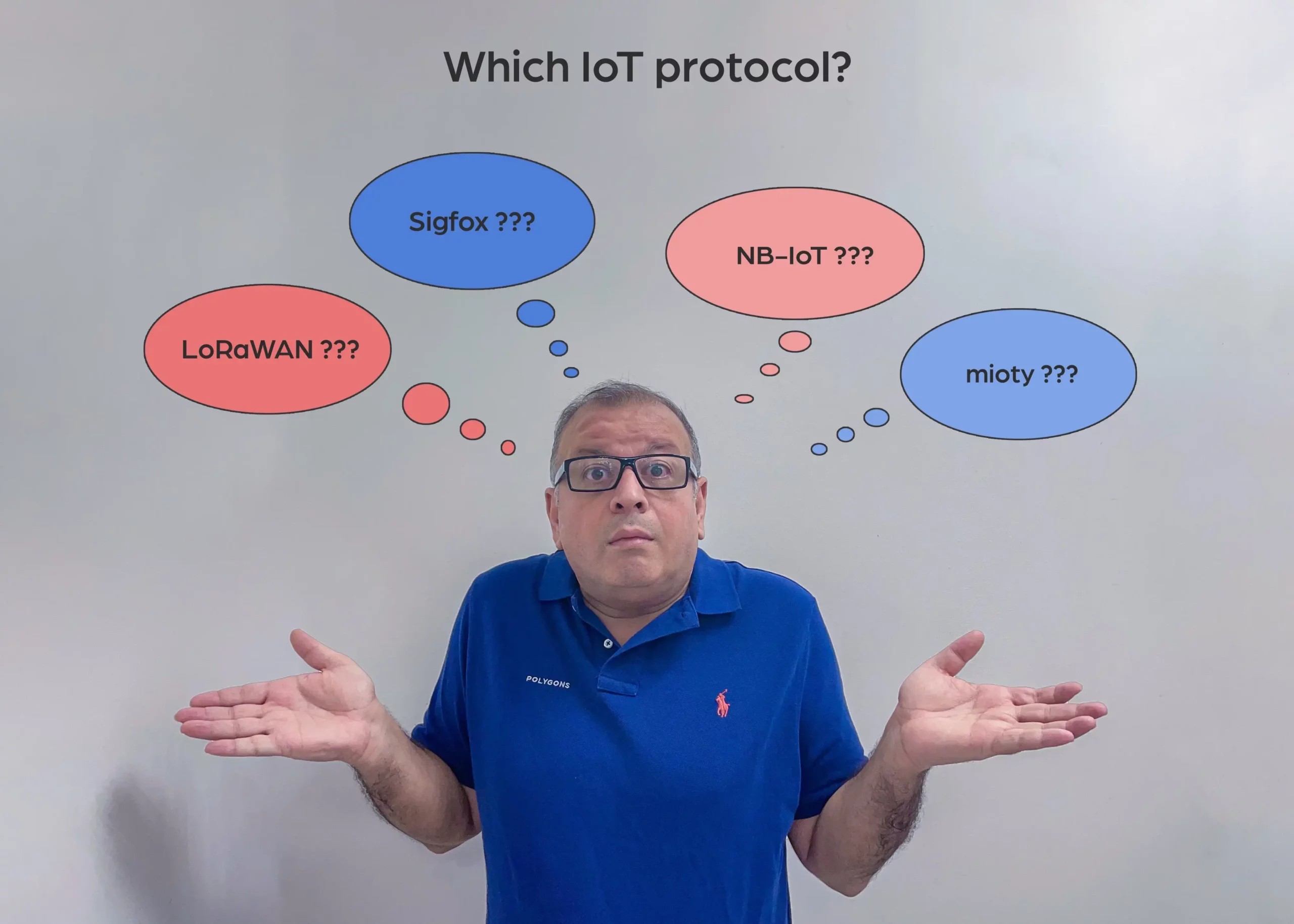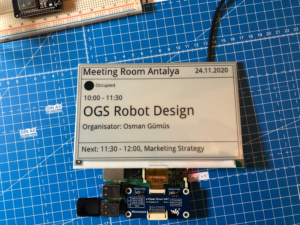In this 2-part series of articles, I will compare some LPWAN (Low Power Wide Area Network) protocols according to specific criteria. At first, we look at LoRaWAN and Sigfox.
We examine the following aspects for the comparison:
- Technology
- Connection of the devices to the network
- Fault Tolerance
- Energy consumption
- Range
- Frequencies and modulation
- Transmission speed
- Security
- Costs
- Available chips and modules
Which protocols are best suited for your application depends on your area of application and requirements and is determined by factors such as:
· Are the sensors stationary or moving (e.g. mounted on vehicles)?
· Over which area are the sensors distributed?
· Are the sensors located in open areas, built-up areas or even in buildings?
· Do you have the resources to manage a network of devices and gateways?
This comparison will help you choose the proper protocol for your use case.
The range of these protocols is significantly higher than Wifi, and the energy consumption is low, making them particularly suitable for wireless sensors.
Let’s first look at where we would locate LPWAN in the OSI 7-layer reference model. LPWAN protocols can be assigned to layer 1 (physical layer), layer 2 (data link layer) and layer 3 (network layer).
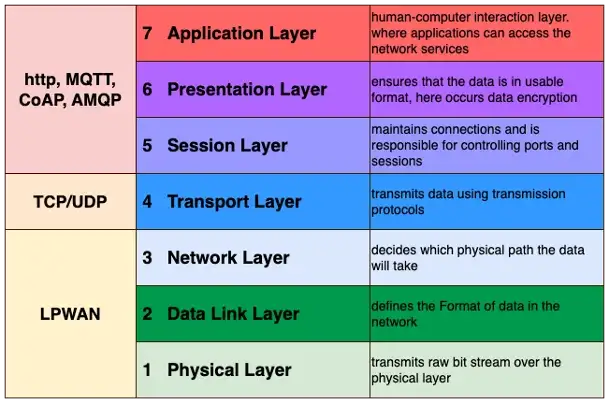
The application protocols, such as MQTT and CoAP, are assigned to layers 5 to 7.
LoRaWAN
Technology
LoRa is a proprietary wireless mediation technique developed by Semtech.
LoRaWAN, on the other hand, is a LoRa-based communication protocol that is being standardised and further developed by the LoRa Alliance.
Unlike LoRa, the application and network layer of LoRaWAN is open source.
The LoRaWAN Alliance has over 500 members, and LoRaWAN has grown in popularity in recent years.
LoRa’s great advantage lies in the possibility of creating private networks, which makes using LoRa in industry and research interesting early on.
Connection of the devices to the network
With LoRaWAN, it is possible to set up private sensor networks or to use public LoRaWAN networks such as TTN (The Things Network). The sensors communicate with LoRaWAN gateways, and the gateways forward the data to servers or the cloud. LoRaWAN devices cannot communicate directly with each other.
LoRaWAN also works according to the “Dumb Gateway” — “Smart Cloud” principle. This means that a node is not assigned to a gateway, but its data to all available gateways.
Manufacturers of LoRaWAN devices must provide their devices with a unique Device Identifier (Device EUI) and Application Identifier (AppEui). This makes it possible to clearly identify all sensors within the network.
LoRaWAN has two options to connect devices to the network:
- ABP (Activation by Personalisation). The ID of the sensors are configured and stored on the gateway
- OTAA (Over the Air Activation). Sensors automatically register with the gateway.
A gateway can handle several hundred sensors (nodes).
frequencies and modulation
LoRaWAN uses the unlicensed ISM (Industrial, Scientific and Medical) frequency bands (EU 868 MHz, USA 915 MHz, Asia 433 MHz).
Bidirectional communication is provided by Chirp Spread Spectrum (CSS) modulation, which spreads a narrowband signal over a wider channel bandwidth.
CSS is a technique that uses broadband linear frequency modulated chirped pulses to encode information. A chirp pulse is a sweep of frequencies over the appropriate bandwidth (125kHz, 250kHz…).
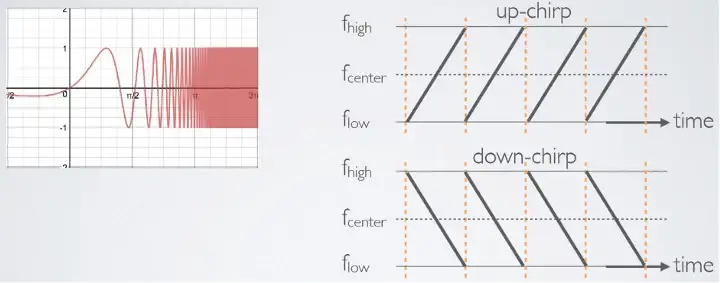
LoRa defines seven spreading factors (SF7 to SF12). Higher spreading factors enable longer ranges but lower transmission rates.
Transmission rate
Depending on the device class, LoRaWAN achieves transmission rates of between 0.3 and 50 kbps.
Power consumption
LoRa chips are in sleep mode when no data is being transmitted or received and consume a sleep current of around 100nA.
With a transmission power of 20dBm, a current of 120mA is consumed.
Due to this relatively low power consumption, depending on the transmission interval and the device battery, a battery life of several years is possible.
Range
LoRaWAN has a range of 5 km in urban areas and a range of up to 20 km in rural areas.
Security
Secure radio transmission with LoRaWAN is guaranteed using three different 128-bit AES keys: A key that is only known to the application and the device, an application session key and a network session key. These prevent third parties from eavesdropping on the data stream.
Costs
The hardware costs vary, of course, depending on the provider and design, but cheap hardware components can be purchased for LoRaWAN and assembled by yourself.
If you operate the gateway yourself, there are additional costs for operating the gateways.
Available chips and modules
Semtech owns the LoRa Intellectual Property (IP), but has licensed the IP to other chip manufacturers like Microchip, STMicroelectronics and HopeRF.
Semtech manufactures many different chipsets that make it possible to use LoRa for your devices. Modules and hardware from various LoRa Alliance vendors and third-party vendors are also offered.
Here is an overview of popular LoRa chips for devices (nodes) which offer a SPI bus for integrating with your Microcontroller:
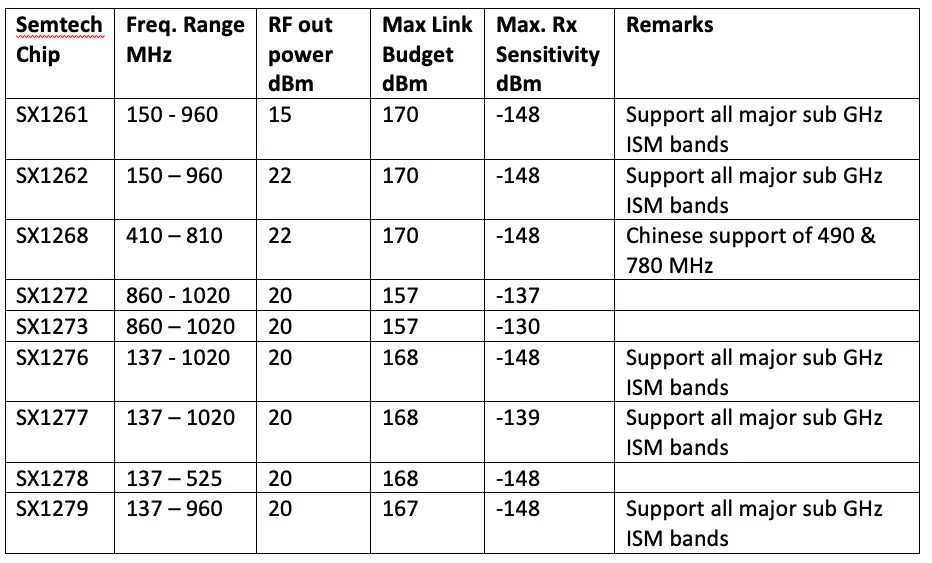
HopeRF offers LoRaWAN modules that you can use for prototypes.
Sigfox
Technology
Sigfox is a french company which operates a LPWAN Network using its patented technology.
With Sigfox it is not possible to build up a private network, you can use the Sigfox network for a fee. Sigfox-compatible and certified hardware can only connect and communicate with the LPWAN managed by Sigfox.
Sigfox is aiming for global coverage, but currently, mainly parts of Europe and America are covered.
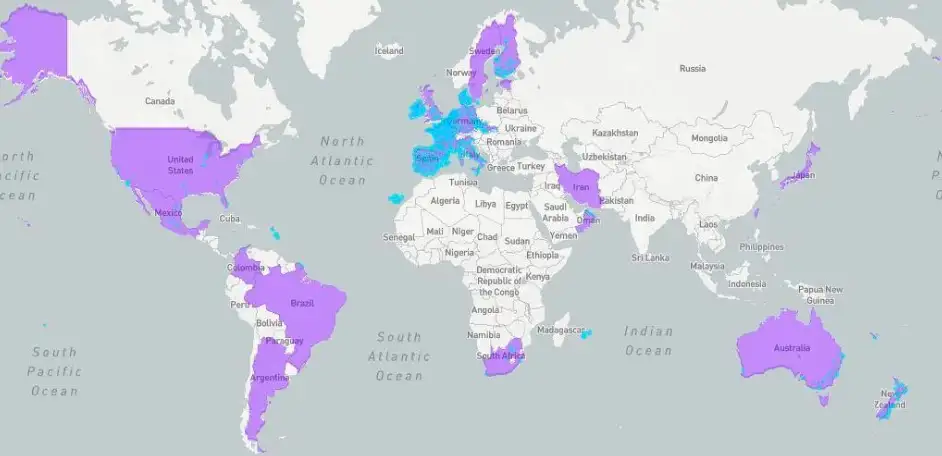
Because the specifications are kept secret and are not publicly available, I can write less than about LoRaWAN.
Connection of the devices to the network
Sigfox deploys its proprietary base stations equipped with cognitive software-defined radios and connect them to the back end servers using an IP-based network.
In order to connect to the Network you have to be in region with coverage and have to pay the fees. For developing prototypes for regions without coverage a Sigfox Simulator is available.
The number of messages over the uplink is limited to 140 messages per day. The maximum payload length for each uplink message is 12 bytes. However, the number of messages over the downlink is limited to four messages per day, which means that the acknowledgment of every uplink message is not supported. The maximum payload length for each downlink message is eight bytes.
frequencies and modulation
Sigfox also uses the unlicensed ISM (Industrial, Scientific and Medical) frequency bands (EU 868 MHz, USA 915 MHz, Asia 433 MHz).
The end devices connected to Sigfox base stations use binary phase-shift keying (BPSK) modulation in an ultra-narrow band (100 Hz) sub- GHZ ISM band carrier.
Transmission rate
The transmission rate of Sigfox is between 100bps and 600bps, depending on the region in which the device is used. Only 100bps are possible in Europe — to avoid exceeding the frequency occupancy period.
Power consumption
Sigfox is licensing its technology to chip manufacturers like Texas Instruments and Atmel. Since different manufacturers produce chipsets, the values for power consumption vary slightly depending on the device, but are always in a range of 50–70mA with a transmission power of 14dBm. Sigfox devices from Telit only consume 1.5 μA in sleep mode.
Range
Sigfox states that it can cover between 30 and 50 km in rural areas. In densely populated areas or cities, the range drops to 3–10 km.
Security
Little is known about the security mechanism in
Costs
Sigfox has its hardware manufactured in large quantities by companies such as Atmel and Texas Instruments. Chips and other units can be purchased in bulk for under $10 each.
The business model of Sigfox is not selling hardware but selling services and the access to its network.
There are different packages for accessing the network.
Available chips and modules
There are a lot of chip manufacturers who have licensed the technology and producing Sigfox chips.
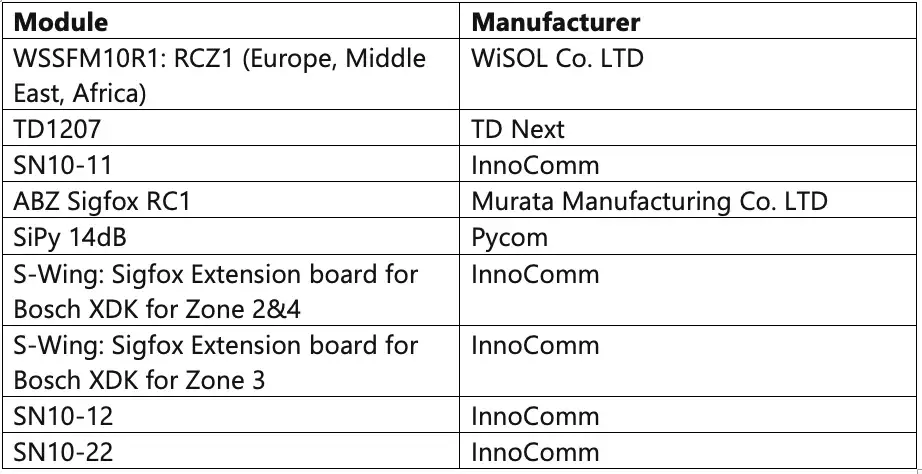
Sigfox offers a Portal for Developers with a lot of information about Chips, Modules and Emulators.
In Part 2 of this article series i will compare NB-IoT and mioty.

